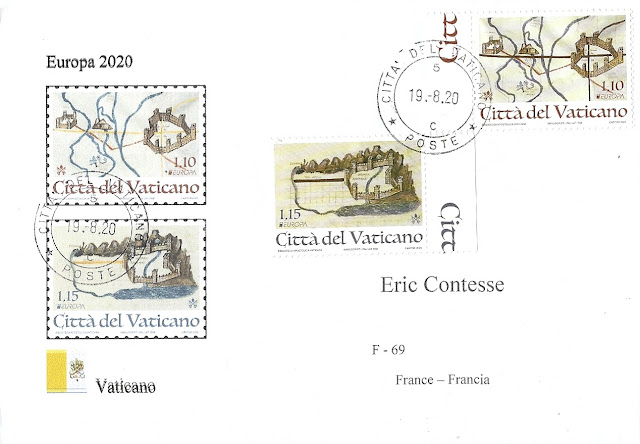Série commune "Capitales européennes de la culture 2020" sur FDC d'Irlande
Avec Galway en Irlande (après Dublin en 1991 et Cork en 2005), la ville
de Rijeka s'est vue décerner (par l'Union européenne) le titre de "Capitale européenne de la
culture" pour l'année 2020, une première pour la Croatie.
Instauré en 1985 (Athènes fut la première ville désignée), ce titre
permet
aux villes (et régions) concernées de présenter leurs richesses
culturelles à travers de nombreuses manifestations, près de 1000 pour
Rijeka (théâtre, musique, expositions, architecture, danse,
projets éducatifs...) et de nombreux événements théâtraux, littéraires,
musicaux, dansants, cinématographiques, architecturaux, culturels,
sportifs et gastronomiques pour Galway (avec un focus sur les thèmes des
paysages et des langues).
Le 23 janvier 2020, les administrations postales des 2 pays ont mis en
circulation une très jolie série commune (2 timbres) consacrée à cette
thématique et ces 2 villes de Galway et Rijeka en particulier.
La version irlandaise de cette série commune figure sur le FDC officiel ci-dessous, avec TAD faisant référence au nom gaélique
de Galway ("Gaillimh").
With Galway in Ireland (after Dublin in
1991 and Cork in 2005), the city of Rijeka has been awarded (by the
European Union) the title of "European Capital of Culture" for the year 2020, a first for Croatia.
Established in 1985 (Athens was the
first
designated city), this title allows concerned cities (and regions) to
present their cultural wealth through many events, about 1000 for Rijeka
(theater, music, exhibitions, architecture, dance , educational
projects...) and many theatrical, literary, musical, dancing,
cinematographic, architectural, cultural, sporting and gastronomic
events for Galway (with a focus on the themes of landscapes and
languages).
On January 23, 2020, the postal
administrations of the 2 countries put into circulation a very nice
joint set (2 stamps) dedicated to this theme and these 2 cities of
Galway and Rijeka in particular.
The Irish version of this joint series is featured on the official FDC below, with a postmark referring to the Gaelic name of Galway ("Gaillimh").

La Claddagh ring ("bague de Claddagh"), une bague traditionnelle irlandaise, offerte pour des fiançailles ou portée comme alliance, est représentée sur le TAD ainsi que sur le timbre consacré à Galway (tarif domestique "N" pour un envoi jusqu'à 100g, 1,00€ actuellement, tirage : 150000), conçu par Steve Simpson.
Ce timbre représente également le Long Walk, l'arche espagnole et la tour de l'université nationale d'Irlande, un hooker (bateau de pêche traditionnel), le blason de la ville ainsi qu'une chouette, symbole du défilé de rue de la compagnie Macnas. Ce timbre évoque également les nombreux festivals
musicaux organisés chaque année dans cette ville (guitare et notes de
musique).
L'autre timbre (tarif domestique "N" pour un envoi jusqu'à 100g, 1,00€ actuellement, tirage : 94000), conçu par Tomislav Tomić, est consacré à Rijeka, avec la tour de l'horloge (ou tour de la ville), la cathédrale Saint-Guy et
l'église Notre-Dame de Trsat, ainsi que son célèbre carnaval, le
plus ancien du pays, et ses déguisements de paysans appelés "zvoncari",
des personnages affreux couverts de poils et de laine...
The Claddagh ring, a traditional Irish ring, offered for engagement or worn as a wedding ring, is featured on the postmark as well as on the Galway stamp (domestic rate "N" for shipment up to 100g, currently € 1.00, print run: 150,000), designed by Steve Simpson.
This stamp also shows the Claddagh seafront buildings, the Spanish Arch and the Tower of the National University of Ireland, a hooker (traditional fishing boat), the coat of arms of the town and an owl, symbol of the street parade of the Macnas performance company. This stamp also evokes the many musical festivals organized each year in this city (guitar and musical notes).
The other stamp (domestic rate "N" for a shipment up to 100g, currently € 1.00, print run: 94,000), designed by Tomislav Tomić, is dedicated to Rijeka, with the clock tower (or city tower), Saint Vitus cathedral and Church of Our Lady of Trsat, as well as its famous carnival, the oldest in the
country, and its disguises of peasants called "zvoncari", awful
characters covered in hair and wool ...



















